
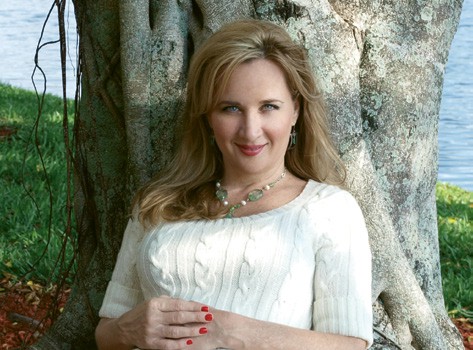
A One-Woman Force for Inclusion
Deborah Davis had visited many parts of the world, but she still yearned to experience a rainforest and jungle. So she set her sights on Belize, spending “hours and hours and hours of planning, arranging everything and leaving nothing to chance.” She set off to that country on the northeastern coast of Central America late last year, a perfect trip for a woman who once wrote, “travel and love are how I survive. I take my love and my will with me and I look strangers in strange lands in the eye as I roll by, and I am saying to myself and to everyone who sees me that we are not pathetic, sad, miserable cripples.”
Davis has made it her mission to change the perception of people with disabilities, not just in the United States but around the world — through photography, words, contacts, and savvy marketing. “I won’t rest until every time you open any magazine you see a person with a disability,” she says in a phone interview from her home in Broward County, Fla. Her strategy includes supplying high-quality photos featuring people with disabilities to every major advertiser and every form of media through PhotoAbility, a project that has earned her the honor of being chosen as NEW MOBILITY’s 2013 Person of the Year.
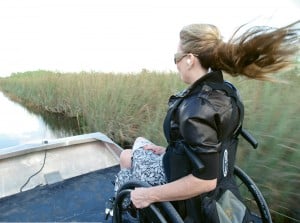
PhotoAbility, started in 2011, houses a stock photo library with images featuring people with disabilities doing everyday things, from exercising to traveling, from dating to kayaking. Stock photography businesses sell photos for specific use to media ranging from daily newspapers, monthly magazines, corporate brochures and college publications to websites, blogs and social media. Photos are usually matched to the specific topic of the article or publication.
“We feel that once we are represented by a true and complete reality of our lives — going on dates, on the job, participating in sports, going shopping, enjoying a glass of wine, a good restaurant, and all the good things life has to offer — it will be understood and accepted that we should be provided accommodations and consideration that recognize how valuable our contribution really is to all these industries,” Davis says on PhotoAbility.net.
She is well on her way. PhotoAbility opened with 40 images and has grown to 1,800, with Davis creating and producing many of the photo shoots and working directly with the photographers and models. Sometimes, she’s done the modeling herself.
All Roads Lead to This
Davis’ life experiences, professional know-how, natural talents and abilities have meshed perfectly for her crusade to change attitudes on a global level — thus creating a more inclusive world.

She grew up with two older brothers “who taught me to be tough,” spending summers in Florida and the school year in Maryland after her parents divorced when she was 2 years old. At 18, she was involved in a car accident, sustaining a C6-7 spinal cord injury, resulting in incomplete quadriplegia.
She describes her mother as “a strong, Southern, seat-of-your-pants, make no excuses, tough-love type of mother. She was very affectionate, but she required me to be independent and self-sufficient. This had a huge impact on my rehab, my strong spirit and my fighter instinct. I completely credit her for kicking my butt, and making me get out of bed, be independent and go to college.”
After attending high school in Florida, she was accepted to the University of Miami, where she majored in finance and earned a bachelor’s degree in business administration. Starting college so soon after the accident was traumatic. “My mother put me on the flight to Miami from Maryland as I was crying my eyes out, not wanting to face a campus full of 18-year-old peers.”
Her father met her at the airport and literally pushed her through college registration, as the airline broke her first and only chair and she was given a large E&J loaner. “The school gave me a single dorm room and took off the door. I learned to transfer from toilet into tub. Within two weeks, I had a best friend, learned to push myself to class and had a boyfriend! I never looked back.”
* * *
After earning her degree, Davis’ career spanned many areas: sales and marketing of medical equipment and supplies; ADA consultant and trainer; fundraiser for nonprofits; director of development/public relations and also executive director of Abilities of Florida.
With such a full resume, she is described by her close friend and business partner, Bill Forrester, as “one of the most capable and intelligent people I have ever had the pleasure to meet. She still astounds me with her energy, vision and capacity to change the world.” Davis was also appointed to the Brain and Spinal Cord Injury Board for the State of Florida, served as president of the Business Coalition for Americans with Disabilities and vice president of the Florida Rehabilitation Association.
All this time she was married and raising two daughters, now 20 and 22 years old.
“People always ask me what it’s like to have been raised by a mother in a wheelchair,” says daughter Alexandra Van De Water, “and it’s funny because I never know how to answer that question. She never made it an issue. She never let it inconvenience her or our lives, so it’s like it’s never been there. She is who she is — an incredible woman, mother and human being. The chair just comes along for the ride.”
After 20 years of working for others, Davis retired because of what she described as “a full-blown rebellion of her body” resulting from post-injury issues — fatigue and overuse syndrome — which affected the use of her arms and hands.
“I had to let everything rest and calm down,” she explains, adding that she’s determined not to let her body break down like that again. “I used to think, ‘I don’t have time’ [to rest or exercise]; I never got away from the computer.”
These days, she does something physical every day — “either swim, work out, or just push down the street. In the pool I’m the most creative; I get lots of ideas. I also feel better, and the movement helps to fight swelling and the mental fog.” Even with the physical setback, those who know Davis best recognized she’d never just sit around and watch television all day.
“She loves to meet new people and talk to them,” says her other daughter, Hannah Van de Water. “She is genuinely excited and interested to spend time with others, and this happens to make her a great sales person. She’s also aggressive, which is good, too. Not in a necessarily combative way, either. My mother can steamroll you with gregariousness — I used to hate that as a kid, but now I’m kind of impressed by it.”
A Second Act
Davis met Bill Forrester in 2007 while he was organizing a trip for a group of disabled sailors from Australia to a world championship. Sharing a similar vision, together they developed PushLiving.com, a travel, leisure and lifestyle enterprise, and its division, TravAbility.
“TravAbility has three main goals,” says Forrester. “The first is to present information that enables travelers with a disability to make informed travel decisions and highlight destinations that are suitable for their needs.” Second is to advocate for shifting the paradigm away from a disability rights issue, in favor of an economic argument: Inclusive tourism can be profitable. “Third, is the consultancy work we are doing to help the industry understand the needs and aspirations of the disabled traveler in order to help them develop and market tourism.” By 2020, he says, it is estimated that 25 percent of all travel expenditure will be by people with a disability.
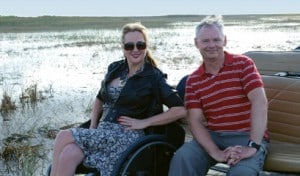
The partners wanted their business to guide the travel, leisure and lifestyle industry to do a better job of communicating inclusive design and benefits in their advertising and marketing campaigns. And since many of the travel venues don’t have time and/or money to set up a photo shoot featuring a person with a disability enjoying the vacation facility, the need for PhotoAbility became clear.
“PhotoAbility was born in the Florida Everglades one afternoon,” says Forrester, “with Deb as the model and me as the photographer perched over the front end of an airboat. What we were trying to purvey in that photo shoot was someone with a disability out and about doing a quintessential Florida activity,” explains Forrester, a native of Melbourne, Australia.
For Davis personally, that was a bit of a leap. “I wasn’t much of an adventure traveler,” she recalls. “I was happy with just eating and drinking and absorbing the local culture. But I’m trying to change that. I’m trying to push myself out of my comfort zone” — and she did just that by going zip lining and snorkeling while in Belize last year.
Alexandra remembers a cruise to Mexico. “Nothing was accessible off the boat. I was popping wheelies left and right with her, pushing her down stone walkways that made the chair wobble and bounce. But we had a blast! She has never let it inhibit her fun. Where there’s a will there’s a way, and she has a very strong will when she sets her mind on something. It was just a matter of finding a way around whatever the issue was. “
Davis is banking on PhotoAbility to change current mainstream views of disability — “the image of being unable, ugly, weak, dependent, having no fashion sense, clunky and boring, to the truth that disability is a life experience that reflects the surrounding vibrant, vigorous living-life world,” explains her friend and colleague, Candace Cable. “And, yes, she will do this because an image can create change.”
The Challenge: Break Into Mainstream Media …
PhotoAbility’s website went live in March 2012. “People who sell products and services to the disabled community noticed our services,” says Davis. She has been asked to arrange special photo shoots on college campuses and for specific businesses, such as a shoot in a sculpture garden at a Raleigh, N.C., museum.
Maria Gast describes her modeling experience for PhotoAbility as wonderful. “Before the photo shoot we had conference calls to plan when everybody would meet up and what we wanted to wear. The photo shoot was well organized, and I got an amazing opportunity to meet amazing people.”
But since most of PhotoAbility’s clients have been from the disability community, the next hurdle is to break into mainstream advertising. Davis, her partner and some consultants have been developing an ambitious PR and marketing plan to reach out beyond the disability community. The hard launch of the photo service is scheduled for early 2014.
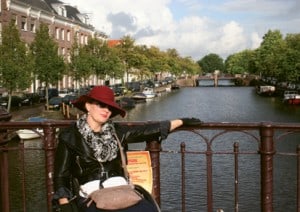
She hinted at some of the planned strategy that includes, in part, setting up booths at conferences to showcase the photography. “We have to create the demand by giving them amazing images,” she says. “We plan to give advertisers the idea by going to their locations, using their products in shoots and sending them the images.” When they see quality lifestyle photos, hopefully the light bulb will go on. “We want it to be the image that sells, not the disability. But the underlying message is that people with disabilities can kayak, can use a catamaran. Why doesn’t Key West market that? Tourism bureaus alone can use these images.”
She cited a photo of a beautiful 17-year-old model with red hair sitting in her wheelchair and shooting photos, “which should be part of an article on photography,” she says. “We just want inclusion.”
Adds Forrester: “We would actually like to see more of our group images just used generally in articles that have nothing to do with disability but represent the fact that 20 percent of the population have a disability.”
According to ABC News, “by some estimates, [Americans with disabilities] have a spending power of $200 billion to $500 billion. For some industries, pitching to the disabled is a unique opportunity, while for others simply including them in ad campaigns could tap into a reservoir of good will that will pay off in brand loyalty.”
Forrester believes the success of Photo-Ability depends entirely on shifting the public, media and advertising industry perception of people with disabilities. “For far too long we have been living with a model of disability that still sees disability as a problem,” he says. Viewing people with disabilities as people first, to be included in all aspects of society, would be game-changing.
Success also depends, adds Davis, on the hard work of the models and photographers. “We want to let the photographers know that what we are doing is working. If they get paychecks, they’ll want to take more images.”
… And Beyond: The Global Influence
Davis will be spending much of the new year building up the photo library and making sure the photos sold to clients are used properly (to protect her models). “We want more shoots for the stock image gallery,” she says, adding that she’s a perfectionist when it comes to the quality of the photos, and all the other details — like contracts, locations and personnel.
“Deborah is very professional and is able to work with the photographer and the model so that it fits everybody’s busy schedule,” says Gast, “and we are all satisfied in the end.”
Will Davis do more modeling? “I would much rather be behind the scenes, producing,” she laughs. “I am so happy when the images come back and are so beautiful. I also can’t wait to tell models the photos have sold.”
Having experienced so many countries in her travels, Davis marvels at the amazing impact our media and advertising have on other countries and cultures. “We need to lead the way and show people with mobility impairments as part of society. Popular consumerism can lead the way and encourage change.”
The reality, though, as reported by ABC News, is that “out of 639 of the largest United States-based public companies analyzed, 31 percent indicated an interest in the market of people with disabilities, but only 7 percent of those backed up that interest with measurable efforts.” ABC News sourced those numbers from an annual report done by Fifth Quadrant Analytics, a New York-based ratings company that focuses on the disability market.
Davis believes that with education and a full-court PR press, those numbers will change. And she’s just the person to do it.
“She has such charisma. People can’t help but be drawn into her and what she has to say,” says Alexandra. “She has a way of relating to all sorts of people and situations, and she has the ability to help you relate to it as well. She refuses to take no for an answer and won’t stop until she has accomplished what she set out to do.”
And while Davis is making Photo-Ability a success, she’s also starting another project — a site for swapping accessible home/vacation properties.
“A lot of my travels have been swaps,” she says, citing trips to Paris and Amsterdam. She rented a fully accessible condo in Berlin, and posted a request for accessible housing on a site like Craigslist for a trip to Melbourne.
The planned new site is another way Davis is working on global inclusion because “there are people with disabilities in all societies who will start to feel pride in themselves when they see other people like us” in the popular media.
Want to Learn More?
• Pushliving.com — inclusive travel, design and living.
• Photoability.net — stock image library featuring individuals with disabilities in travel, leisure and lifestyle settings.
• Travability.travel — provides education, advocacy and accessibility information for travel destinations.
Also check out Push Living, Photo-Ability and TravAbility on Twitter, Pinterest and Facebook.
The Paralyzed Life
As if she isn’t busy enough, another project Deborah Davis plans to tackle this year will mesh her belief in the power of photography with her skills as a boss and mother and the everyday issues of people with disabilities.
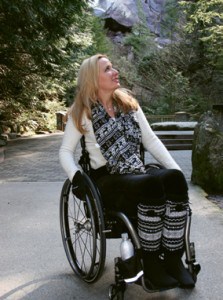
Titled “The Paralyzed Life,” Davis, in partnership with Rachelle Friedman, has highlighted seven concepts that will be illustrated through high-quality photography, then offered free of charge to organizations working on those issues for fundraising opportunities. “The Paralyzed Life” will visually explore:
• Lack of funding for medical equipment and supplies
• Structural accessibility
• Employment
• Lack of accessible parking and enforcement
• Romantic isolation and loneliness
• Need for more research for a cure and pain management
• Lack of accessible housing and being forced to live in nursing homes
Citing her mother’s dedication and initiative, Hannah Van de Water believes she can accomplish anything she sets out to do, even a complicated project like “The Paralyzed Life.”
“She has the ability to remain positive throughout any challenge,” Van de Water says. “She is always kind and affectionate, but she will never put up with BS. She is always brutally honest, and I’ve come to really appreciate that, because I’ve come to be able to accept and even desire constructive criticism.”
There’s no better tribute to Davis’ professional abilities and goals than that.
Support New MobilityWait! Before you wander off to other parts of the internet, please consider supporting New Mobility. For more than three decades, New Mobility has published groundbreaking content for active wheelchair users. We share practical advice from wheelchair users across the country, review life-changing technology and demand equity in healthcare, travel and all facets of life. But none of this is cheap, easy or profitable. Your support helps us give wheelchair users the resources to build a fulfilling life. |


Recent Comments
David Anderson on Phoenix i is the First Wheelchair with Integrated Power Assist
Dan on Phoenix i is the First Wheelchair with Integrated Power Assist
Andrew Slorance on Phoenix i is the First Wheelchair with Integrated Power Assist